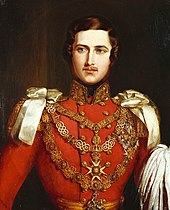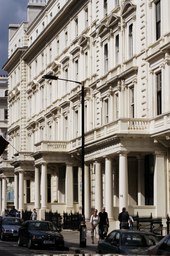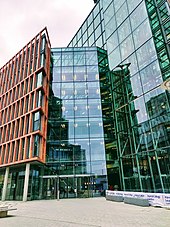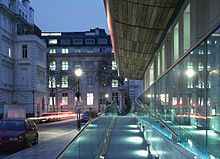Imperial College London
An enormously popular and financial success, proceeds from the Great Exhibition were designated to develop an area for cultural and scientific advancement in South Kensington.
[22][23] On 8 July 1907, Edward VII granted a Royal Charter establishing the Imperial College of Science and Technology.
[29][30] The college also acquired a biology field station at Silwood Park near Ascot, Berkshire in 1947[31] Following World War II, there was again concern that Britain was falling behind in science – this time to the United States.
[36] Opposition from the Royal Fine Arts Commission and others meant that Queen's Tower was retained, with work carried out between 1966 and 1968 to make it free standing.
[45][46][47] In April 2011, Imperial and King's College London joined the UK Centre for Medical Research and Innovation as partners with a commitment of £40 million each to the project.
[49] In 2014, Stefan Grimm, of the Department of Medicine, was found dead after being told that he was "struggling to fulfil the metrics" of his professorial post.
To the north, within easy walking distance of the college, are Kensington Gardens and Hyde Park, with green spaces and sports facilities used by many of the student clubs.
[55][56] The campus is home to the Scale Space and incubator, Invention Rooms, a college hackerspace and community outreach centre.
[57] The White City campus also includes another biomedical centre funded by Sir Michael Uren.
The Silwood Park campus remains a centre for research and teaching in ecology, evolution, and conservation.
[64] The university also houses two academic centres offering teaching to undergraduate and postgraduate students in subjects outside of science, technology and medicine.
It is a founding member of the Imperial College academic health sciences centre, the Francis Crick Institute and MedCity.
Imperial is a long-term partner of the Massachusetts Institute of Technology, with the first formal large-scale collaboration agreement dating back to 1944 as part of World War II scientific effort.
[74][75] Imperial researcher Narinder Singh Kapany made critical contributions to the invention of fibre optics.
[93] The undergraduate courses with the highest ratios of applicants to admissions were computing (19.2:1), mathematics (14.6:1) and mechanical engineering (11.2:1).
[92] The postgraduate courses with the highest ratios of applicants to admissions were computing (21:1), mathematics (17.9:1), and electrical engineering (14:1).
[97] 36.5% of Imperial's undergraduates are privately educated, the fourth highest proportion amongst mainstream British universities.
Imperial is known for its hardworking and fast-paced entrepreneurial culture, which blends business studies with a science-based curriculum.
Its strategic collaborations with institutions around the world have led to advancements that inform industries and public policy.
Imperial's specialised focus on practical subjects—engineering, science, medicine, and business—along with its emphasis on entrepreneurship and industry collaborations, has made it a leader in the UK for successful career outcomes.
[121] Imperial's male to female ratio for undergraduate students is uneven at approximately 64:36 overall,[121] and 5:1 or higher in some engineering courses.
The department had bought an early AMPEX Type A 1-inch videotape recorder and this was used to produce an occasional short news programme which was then played to students by simply moving the VTR and a monitor into a common room.
Trips have included Afghanistan, Alaska, Cameroon, Ethiopia, Fiji, the Himalayas, Iran, Morocco, Norway, Tanzania, Thailand, Ukraine, and the Yukon.
It is additionally one of the London-based dramatic societies to participate in the London Student Drama Festival,[137] and regularly attends the Edinburgh Fringe.
[139] Imperial College owns and manages ten halls of residence in Inner London, Acton and Ascot, Berkshire.
Over three thousand rooms are available, with first year undergraduates guaranteed a place in one of the six main college residences (subject to certain requirements).
The majority of halls offer single or twin accommodation with some rooms having en suite facilities.
[143] Fields medalists have included Klaus Friedrich Roth, Sir Simon Donaldson and Martin Hairer.
[149] Other alumni have included: Adventure and Exploration: Sir Roger Bannister, ran the first four-minute mile;[150] Andreas Mogensen, first Danish astronaut; David Warren, inventor of the flight data recorder and cockpit voice recorder;[151] Nikolas Tombazis, chief car designer at McLaren and Ferrari;[152] and Nicola Fox, Head of Science at NASA.
[153] Politics: Sir Julius Vogel, former Prime Minister of New Zealand;[154] Rajiv Gandhi, former Prime Minister of India;[155] Teo Chee Hean, Senior Minister of Singapore (formerly Deputy Prime Minister of Singapore); Edem Tengue, Minister of maritime economy of the republic of Togo; Henry Charles Stephens, politician; Chen Jining, Mayor of Beijing, Secretary of Shanghai;[156] Dyah Roro Esti Widya Putri, member of House of Representatives of the Republic of Indonesia; Business: Ralph Robins, CEO of Rolls-Royce; Chew Choon Seng, CEO of Singapore Airlines; Cyrus Pallonji Mistry, chairman of the Tata Group;[157] Ian Read, CEO of Pfizer; Iain Conn, Managing Director of BP; Danny Lui, co-founder of Lenovo; Michael Cowpland, founder of Corel;[158] Alan Howard, co-founder of Brevan Howard and philanthropist; Michael Birch, entrepreneur; Andrew Rickman, UK's first tech billionaire;[159] and Sir Michael Uren, businessman and philanthropist.




















